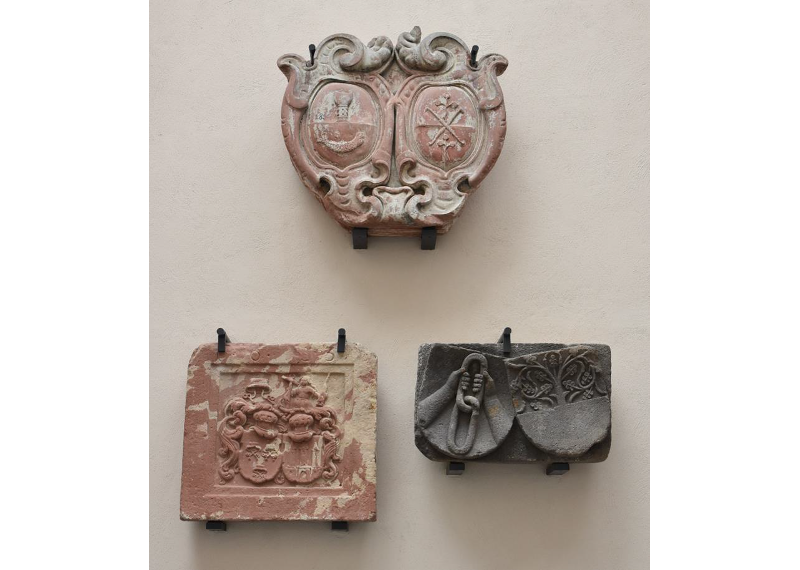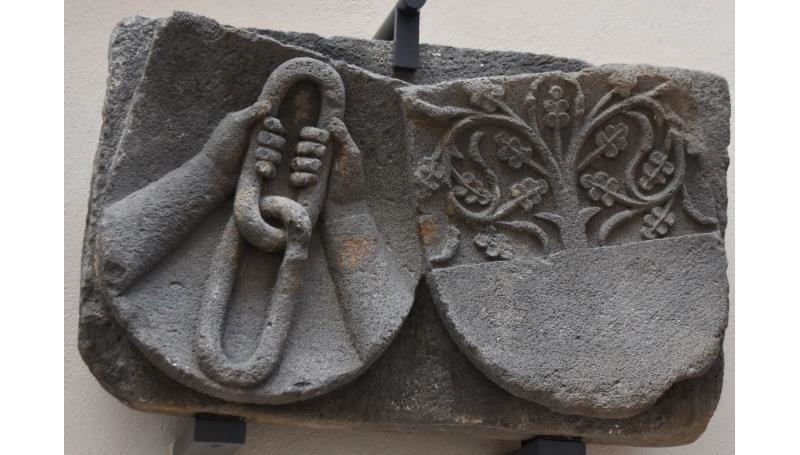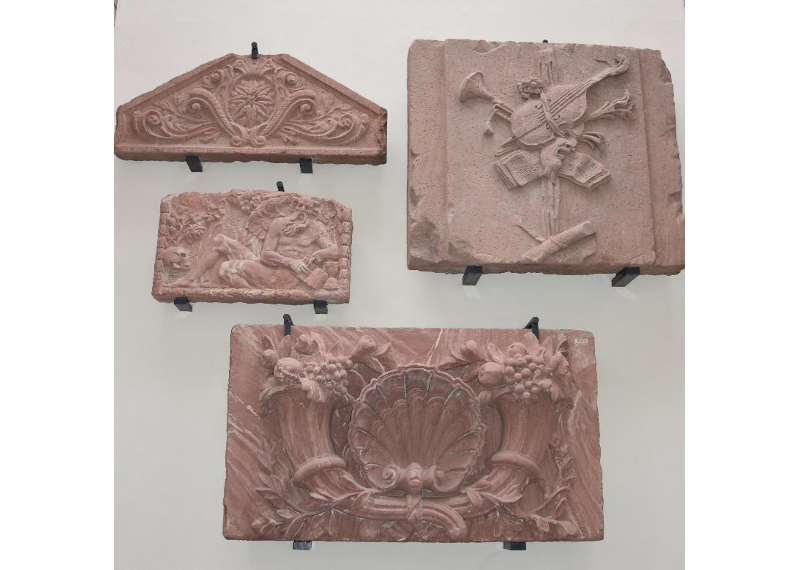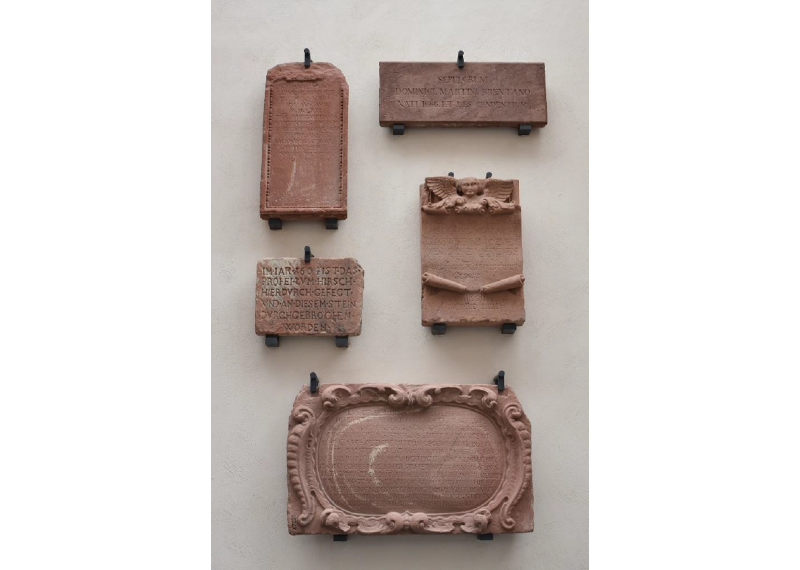Spolia wall on the exhibition house
Niche 1 - Window arch stones

Arch keystone, 18th century.
House Frauenrode
The arch capstone shows the middle section of a segmental arch with a rococo cartouche with a tuft of grass. It comes from the Haus Frauenrode. The building was acquired by the town in 1424. It was used as a council chamber and writing room. In 1438, the Frauenrode Tower was the first building in Frankfurt to be erected solely for archive purposes. In 1747 an extensive reconstruction took place. The stones on the museum wall, which entered the museum after the demolition in 1900, also date from this period. Today, the Römer's Bürgersaalbau is located on the site of Frauenrode.
Niche 2 - crest stones

Coat of arms, around 1680
House Clesernhof
The stone was located above the gate building at Kerbengasse 11 in a broken gable field. The coats of arms stand for the builders of the Glesernhof (Gläsernhof): Peter Gläser and his wife Anna Maria Rasor. The left field shows a baroque knobbed glass with a jumping fish below. The glass symbolises the name Peter Kaspar Gläser von Gläserthal (died 3.11.1689). Peter Gläser originally came from Saalfeld.
The jumping fish in the left field of the stone is part of the coat of arms of Saalfeld. Here it refers to the birthplace of the owner of the house. In the right field of the stone you can see a squared shield, covered with two hoes placed in the St. Andrew's cross, above and below a clover leaf. It is the coat of arms of the Rasor family. Anna Maria Rasor (1652-1696) was the wife of Peter Kaspar Gläser. The Rasor family provided syndici (legal advisors) to the city of Frankfurt for several generations. In 1742 the municipal stable master Martin Rasor (before 1685-1742) became a member of the Frauenstein Society.
The history of the Clesernhof (originally Gläser-Hof)
- 1564: built by Johann von Glauburg
- Peter Kaspar Gläser (since 1686 ennobled by Gläserthal) acquired the estate and had it rebuilt in 1682/83. Merchant Gläser is a brass and scrap dealer.
- 1863: The town acquires the building
- 1867 - 1887: Royal Prussian Police Presidium
- 1882: Explosive attack with dynamite
- 1885: Killing of the head of the Frankfurt criminal police (Ludwig Rumpf) by a 20-year-old anarchist
- 1900: Demolition (new building Römer)
Coat of Arms, 1653
House "Zur Goldenen Zange", Fahrgasse 57
The sandstone coat of arms panel shows two shields with coats of arms and the date 1653. Three kettle hats adorn the left coat of arms, the upper crest is here also a kettle hat. The right coat of arms shows a massive city wall with city gate, behind it three large towers. Here the crest shows a long-haired woman with a large anchor in her arm. The plaque was broken and has been restored.
The Ketelhodt family (different spellings possible) was a noble family of Lower Saxony and Mecklenburg, which can be traced back to 1230. They had resided in the principality of Schwarzburg-Rudolstadt since the first half of the 18th century. The first representative of the family at the Ganerbengesellschaft (community of joint ownership) of the House of Alten-Limpurg was Carl Ulrich von Ketelhodt (1773 - 1832).
Coat of arms, middle 15th century.
Origin unknown

The basalt wall plaque with a double shield shows the coats of arms of Rohrbach and Wixhäuser (Wickenhausen). Johann Rohrbach marries Else Wixhauser (also Wixhäuser), the daughter of the councilman Heinrich Wixhäuser, in 1428. 1443 Johann is elected to the town council. From then on the Wixhauser Hof appears as Rohrbach's family estate. It is later the Augsburger Hof, then the Wixhauser-, Rohrbacher- or also the old Rahmhof. It was castle-like closed until the big fire of 1719. The stone may have come from this former estate of the Rohrbach/Wixhäuser family. In the Middle Ages, the present Darmstadt district of Wixhausen is referred to in documents as Wikkenhusen (Wikkenhusen (1211), Wicheshusen (1225); Wickershusen (1286), Wixhusen (1295), Wickeshusen (1339)).
Niche 3 - Ornamental, Parapet and Gravestones

Triangular gable, 18th century
House "Zum (Golden) Wolf", Fahrgasse 16
The gable field made of red sandstone has a frugal central motif. The original pediment is lost today. The stone originates from "Haus zum Wolf" ("House to the Wolf"). The two-storey building from the 18th century was extended by one storey around 1864. The gable stone was located above the middle window of the first floor.
Ornamental stone, c. 1753 - 1757
Darmstadt court
The red sandstone ornamental stone comes from the Darmstädter Hof (Darmstadt court). It shows a so-called trophy pendant, which here consists of a violin, a trumpet and music sheets. The stone has been owned by the city since the demolition of the building in 1899.
The extensive Darmstädter Hof building has been in the possession of the Hessian-Darmstadt royal family since 1627 and served as the city residence of the landgraves of Hesse-Darmstadt. After demolition in 1899, the M. Schneider department store was initially located on the property. After the Darmstädter Hof was demolished, the city bought the decorative stones of the baroque street and courtyard facades in order to rebuild the building later in another location. The stones were stored for years in the Frankfurt city forest and, pushed together, served as a rock landscape in an animal enclosure.
Gravestone fragment, late 17th century
The red sandstone plate shows the winged Cronos (Saturn) with book and hourglass. On his left side is a skull from which a rose bush grows. The stone is the lower part of the grave plate of Johann Balthasar von Keib (1637-1697). Keib was lay judge, senator and mayor of the Free City of Frankfurt. The gravestone was found in 1966 during an excavation in the Katharinenkirche.
The inscription translates to:
Dedicated to the most gracious and sublime God
Under this stone rests in Christ
The well-born gentleman Johann Balthasar von Keib
lay judge, scholar and senator of the free city
Frankfurt who saw the light on 12 February 1637.
First married to the noble Anna Margretha
Stalburger who died, then with the noble
Justina zum Jungen, which would make it 10 free
parents (children), of which 8 left her, poured out (died)
3 March 16(97)
Ornamental stone, ca. 1791 - 1793
Former Palais Mumm, Zeil 36
The ornamental stone consists of red sandstone and features a shell motif flanked by cornucopias. It originates from the facade of the Palais Mumm. This stood on the Zeil (number 36). The Palais was built between 1791 and 1793 at the corner of Brönnerstraße for the merchant and banker Johann Friedrich Schmid. Schmid's house was better known as Palais Mumm, named after its later owner Daniel Heinrich Mumm von Schwarzenstein, the first mayor of Frankfurt after the Prussian occupation. Today a Primark department store stands on this site. The ornamental stones, of which one has been preserved here, can be seen on the façade of Palais Mumm between the first and second floors.
Niche 4 - Inscription stones

Inscription stone, after 1755
Family crypt Karmeliterkirche Frankfurt
According to the inscription, the stone comes from the tomb of Domenico Martino Brentano (1686-1755). His father, the progenitor of the family, was Domenico Brentano (1651-1723). He acquired the Beisaßen-Schutz (citizen protection) in 1676 and in 1698 moved the headquarters with branches in Tremezzo, Bingen, and Mainz to Frankfurt. Domenico Martino Brentano was in Italy until 1707. He took over the branches in Mainz and Amsterdam (since 1733). From 1753 he had his own company in Frankfurt. The company headquarters was "Hinter dem Lämmchen/Nürnberger Hof".
The inscription reads:
SEPULCRUM
DOMINICI. MARTINI BRENTANO
NATI 1686. ET DES CENDENTIUM
Translated, that means:
GRAVE
DOMENICO MARTINO BRENTANO
BORN 1686. AND DESCENDANTS
Gravestone, after 1571
Old Peterskirche, choir area
The plate is the epitaph of Daniel zum Jungen (1512-1571) and his wife Margareta Fürstenberger (died 1549) from the choir area of the old Peterskirche, which was demolished in 1895. Dr. jur. Daniel zum Jungen studied in Pavia, was councillor in 1538, younger mayor in 1544, lay judge in 1547 and elder mayor in Frankfurt in 1548, 1557, 1561 and 1567, as well as envoy at the imperial diets of Augsburg in 1550, 1559 and 1566.
The inscription, carved into a recess decorated with pearl staff ornamentation all around, reads translated accordingly:
Mr Daniel (zum Jungen) of this
Republic, lay judge and senator, who died on
died January 15, 1571.
Dame Margretha von Fürstenberg,
of the same charitable wife, who died20 April (15)49.
Hieronymus and Margaritha, the loving children
have erected this monument.
Inscription plate, 17th century.
House "Zur Reuse", Market 23

The red sandstone tablet shows an angel figure above a rolled out scroll.
The inscription reads translated:
HOLDS MUCH SUFFERING IN ALL THINGS
LET THE LORD DO TO YOU
BELIEVE WHAT HE WILL DO TO YOU
HE WILL TURN IT TO THE BEST
PSALM 37
THE HOUSE IS CALLED ZUR REUSE
EVERYTHING IS IN GOD'S HANDS
The passage quoted is not found in Psalm 37.
The plaque comes from the building "Zur Reuse" at Markt 23, which stood at the place where the red sandstone pergola is now located in the New Old Town.
Inscription plate, 1667
Katharinenstift, Zeil 67
The rectangular stone slab was acquired on 12 June 1885. It is made of red sandstone and shows the following inscription in an oval baroque cartouche (translated):
A NOBLE AND HIGH WISE COUNCIL
REMEMBERING THIS CITY OF FRANKFURT
THE WICKHARD FROG LINEAGE AT THIS PLACE AND CANONICUS IN ST. STEPHANS MONASTERY TO MAINZ IN THE YEAR 1354 FROM OWN RESOURCES THIS CHURCH IS PRESENT
AND MONASTERY OF ST CATHARINEN TO PRESERVE A
NUMBER OF VIRGINS AND OLD POOR HONEST
CHRISTIAN MEN IN ANNO 1667. THE
11TH DAY OF MONTH DECEMBER UNANIMOUSLY DECREES THE REPORTED
FOUNDATION IN ACCORDANCE WITH THE ACTUAL REQUIREMENTS FOR THIS PURPOSE
APPLICABLE. THEREFORE ALSO MORE COMFORT BY THE THEN CAREGIVERS OF THIS MONASTERY
CONSTRUCTION
The Katharinenkirche and the monastery had been founded in 1354 by Wicker Frosch for noble women. Wicker Frosch was a Frankfurt patrician and he was canon in Frankfurt and Mainz. He founded a number of institutions that still exist today, including the St. Katharinen- und Weißfrauenstift, a care facility for needy, Christian women of Frankfurt.
A new construction of the Katharinenkirche took place from 1678 to 1681. The inscription on the stone indicates that the deputies of the city's magistrate decided on a new building in 1667.
Inscription plate, 1604
House "Zum Hirsch", Saalgasse
This inscription plate comes from the house "Zum Hirsch" in the Saalgasse. The inscription refers to an occupation that is no longer common today.
It reads:
IN THE YEAR 1604 IS THE
PROFEI (privy) THE DEER
SWEPT THROUGH HERE
AND ON THIS STONE
WAS BROKEN THROUGH
The meaning of "profei" (disfigurement from private) is: pit, cesspool, cloaca, outhouse or toilet. These collecting pits for faeces under the townhouses had to be emptied and cleaned from time to time. This unpleasant work was done by the executioners' assistants. The inscription plate refers to the fact that in 1604 the cleaning of the cloaca in the house "Zum Hirsch" was carried out.
Niche 5 - vaulted keystones
The two upper stones and the first stone in the second row originate from the old Heilig-Geist-Kirche (Holy Spirit Church). They show the family crests Prusse, Leneck and Monis. The Heilig-Geist-Kirche was part of the hospital of the same name and located at the site of the present address "Am Geistpförtchen".
The second stone in the second row was formerly in the old Peterskirche, which was demolished in 1891.
The lower, larger stone comes from the former Clesernhof. There it was embedded in the vault of the back gate entrance. It shows the alliance coat of arms Rohrbach/Werstatt.


